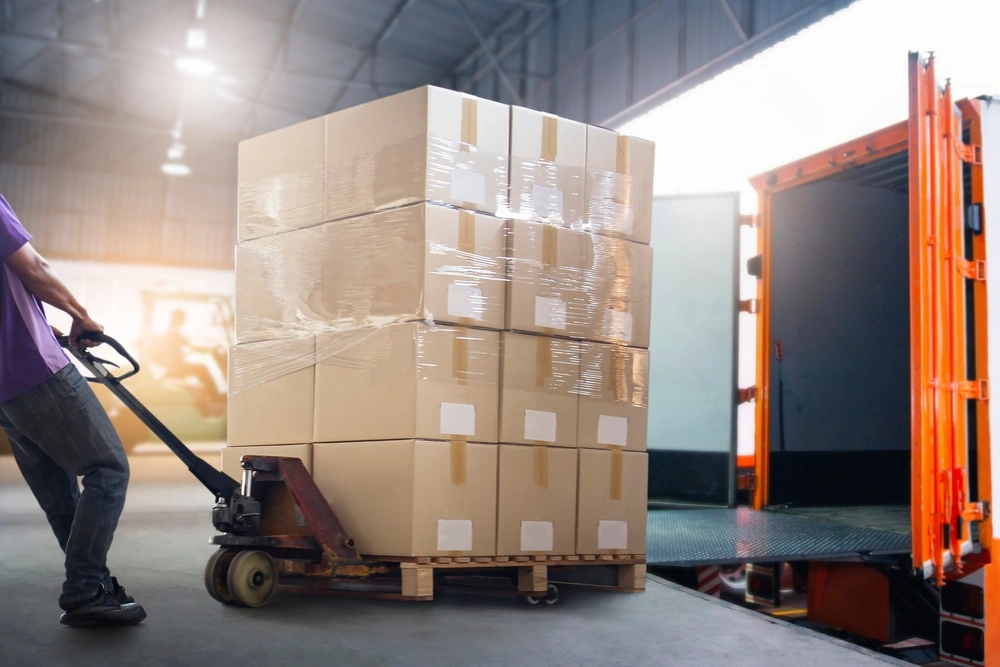In the ever-changing landscape of supply chain and logistics, it’s important for companies to keep up with the latest trends and technologies. One such trend that’s providing a number of benefits to supply chain companies is warehouse cross-docking. But what is cross-docking, exactly? And what are the pros and cons of adopting this practice?
In this post, we’ll take a closer look at warehouse cross-docking and explore some of the key benefits and drawbacks associated with it. We’ll also introduce SphereWMS, a software solution that can help streamline your cross-docking operation and overall supply chain management.
What is Cross-Docking?
Cross-docking is a logistics process in which inbound products are unloaded, sorted, and transferred directly to outbound trucks without being stored in the warehouse, as with traditional inventory management. In other words, products come in one door and go out the other without being stored in between. This type of operation requires close coordination between the warehouse and transportation teams, as well as real-time visibility into inventory levels.
Cross-docking can be used for a variety of different product types, including perishable goods, high-turnover items, and time-sensitive shipments. By eliminating the need to store products in the warehouse, fulfillment operations can reduce their lead times and increase efficiency.
How Does Cross-Docking Work?
A successful cross-docking operation will involve the following steps:
- Inbound products are received at the warehouse loading dock and sorted according to destination.
- Products are then transferred to outbound trucks, which are typically scheduled to arrive just in time for loading.
- The outbound trucks depart for their respective destinations, and the process begins again with the next wave of inbound shipments.
To successfully execute a cross-docking operation, companies need to have a robust warehouse management system (WMS) in place. A good WMS will provide real-time visibility into inventory levels and allow for tight coordination between the warehouse and transportation teams.
What is a Cross-Docking Warehouse?
A cross-docking warehouse is a type of distribution center where inbound shipments can be sorted and loaded directly onto outbound trucks, without being held long-term in the warehouse. Because inventory doesn’t need to be stored, cross-dock warehouses aren’t designed with large volumes of shelving and storage space. Instead, these facilities are designed to minimize handling and improve the flow of products through the distribution process.
In terms of layout, cross-docking warehouses are typically long and narrow, with loading docks on both sides of the facility. This allows inbound shipments to be unloaded on one side and loaded onto outbound trucks on the other side. For larger facilities with many dock doors, T or X-shaped layouts may be used to minimize travel time and maximize efficiency.
The Difference Between Cross-Docking and Warehousing
In traditional warehousing, inbound shipments are stored in the facility until they are needed for an order. This involves storing the products on shelves, in bins, on the floor, or in the yard. When an order is received, a picker will retrieve the products from the warehouse and load them onto an outbound truck.
As we’ve said, in a cross-dock warehouse, inbound shipments are quickly sorted and loaded directly onto outbound trucks, without moving to storage. Products are brought to the picker using a forklift, conveyor system, gravity flow racks, or other methods.
Benefits of Cross-Docking to Supply Chain Companies
There are many benefits that supply chain companies may achieve when implementing a cross-docking process, including:
Reduced Transit Times
Cross-docking can help reduce transit times by eliminating the need to store products in the warehouse. As a result, shipping time to the customer is reduced. This is thanks to products bypassing the inventory storage process and instead being immediately shipped directly to their destination.
Cost Savings
Cross-docking can also lead to cost savings by reducing the time products spend in the warehouse. Products are not stored long-term and do not need to be picked, packed, and shipped separately. This reduces inventory costs. In addition, cross-docking can sometimes help reduce labor costs by eliminating the need for extra staff to handle inventory.
Transportation and shipping costs may also be reduced because cross-docking can help optimize the use of transportation resources. Outbound trucks can be scheduled to arrive just in time for loading, which minimizes empty miles and wasted time. Shipments can also be optimized by consolidating multiple orders into one truck, which can further reduce transportation costs.
Minimize Risk of Damage
Another benefit is that cross-docking reduces the risk of damage to products. Since products are not stored in the warehouse and do not need to be moved around as much, the risk of breakage and other types of damage is minimized.
Improved Customer Satisfaction
Cross-docking can also improve customer service by reducing lead times and increasing order accuracy. This is because once products arrive on incoming transport, they are sorted and loaded directly onto outbound trucks without being stored in the warehouse first. As a result, products can be delivered to customers more quickly and often with fewer errors.
Ready to Enhance Your Cross-Docking Efficiency?
Discover how SphereWMS streamlines your cross-docking operations, enhancing speed and reducing overhead. Our system offers improved visibility and coordination between transportation and warehouse teams, ensuring quick turnaround and cost savings.
Discover MorePotential Challenges and Drawbacks of Cross-Docking
Despite the many advantages of cross-docking, there are also some drawbacks to consider. These aren’t all negatives, but they are potential challenges that companies should be aware of when considering cross-docking.
Requires Close Coordination
Cross-docking requires close coordination between the warehouse and transportation teams. Products are sorted and shipped directly from the inbound trucks, bypassing the need for storage in the warehouse. If the coordination isn’t there, it can lead to errors and delays in shipping.
Requires Real-Time Visibility
Cross-docking requires real-time visibility into inventory levels. Because products are sorted and shipped as soon as they arrive at the warehouse, if there is a delay in receiving information about the incoming shipments, it can lead to errors in the process.
May Not Be Suitable for All Products
Cross-docking may not be suitable for all products. For example, cross-docking may not be suitable for products that are high in value or require special handling.
Can Be Labor Intensive
Cross-docking can be labor intensive because it requires products to be quickly sorted and loaded onto outbound trucks. This can be a challenge if you don’t have enough staff to handle the volume of inbound and outbound shipments.
Can Be Challenging for Small Companies
Cross-docking can be challenging for small companies since it requires close coordination and real-time visibility. These can be difficult to achieve if you don’t have the right technology or enough staff.
Despite these potential challenges, cross-docking can be a beneficial solution for many companies. When done correctly, cross-docking can lead to a reduction in shipping times, cost savings, and improved customer service.
If you’re considering cross-docking for your warehouse operation, be sure to weigh the pros and cons carefully. Cross-docking can be a great solution for many companies, but it’s not right for every operation.
Types of Cross-Docking: Pre-Distribution and Post-Distribution
There are two main types of cross-docking being used in warehouses today: pre-distribution cross-docking and post-distribution cross-docking.
Pre-Distribution Cross-Docking
In pre-distribution cross docking, goods are assigned to customers before they leave the supplier. Incoming inventory is unpacked, sorted, and repackaged according to predetermined distribution instructions before being sent out.
Post-Distribution Cross-Docking
With post-distribution cross-docking, sorting is put off until the right facility and customers are chosen. This means that items may spend a bit more time in the distribution center or cross-docking facility. However, merchants and suppliers benefit from the additional time to make more informed shipping decisions based on inventory data, sales forecasts, and trends.
Three Common Methods of Cross-Docking
In terms of the strategy employed, there are a few common methods of cross-docking used in warehouses today. These methods include:
Continuous Cross-Docking
With the continuous method of cross-docking, there is a continual flow of inventory from inbound shipments through the facility and directly onto outbound trucks.
The result is a single handling of each product, from the time it arrives at the facility until the time it leaves on an outbound shipment. This method is often used for time-sensitive shipments, like fresh produce or perishable goods.
Consolidation Arrangements
Consolidation cross-docking is similar to the continuous method. With consolidation, however, inbound shipments are grouped together before they are sorted and loaded onto outbound trucks.
This method is often used when shipments arrive at the cross-dock warehouse at different times, from different locations, or from multiple suppliers. By consolidating the shipments, the warehouse team can more easily sort and load the products onto outbound trucks.
De-Consolidation Arrangements
De-consolidation is the opposite of consolidation. With de-consolidation, inbound shipments are broken down into smaller shipments before they are loaded onto outbound trucks.
This method is often used when products need to be shipped to different locations or when products need to be shipped at different times. By breaking down the shipments, the warehouse team can more easily sort and load the products onto outbound trucks.
Whichever cross-docking method you choose, it’s important to have a well-designed layout and efficient material handling equipment. Coordination between the warehouse and transportation teams is also critical.
What Types of Businesses Can Benefit From Cross-Docking?
Cross-docking can be used in a variety of businesses, including:
- 3PLs and 4PLs
- Distribution centers
- Supply chain companies
- Manufacturers
- E-commerce businesses
- Retail store chains
Is Cross-Docking Right for My Business?
There are a number of factors to consider when deciding if a cross-docking solution is right for your business. These factors include:
- The type of products you ship
- The frequency of shipments
- The lead time of shipments
- The number of SKUs you ship
- The size and weight of the products
- The storage requirements of products
- The handling requirements of products
- The shipping requirements of products
SphereWMS: Warehouse Management and Cross-Docking System
SphereWMS is a cloud-based warehouse management system that offers a variety of features that can help supply chain managers streamline their cross-docking operations, including:
- Real-Time Inventory Visibility: SphereWMS offers real-time inventory visibility, so warehouse managers can always see what products are in stock. This feature is important for managing cross-docking operations because it allows managers to see when shipments arrive and when products need to be loaded onto outbound trucks.
- Task Management: SphereWMS offers a task management feature that can help warehouse managers coordinate cross-docking operations. This feature allows managers to assign tasks to specific workers and track the progress of each task.
- Shipping Integration: SphereWMS offers shipping integration with major carriers, which can help streamline outbound cross-docking operations. This feature allows warehouses to print shipping labels and track orders in real-time.
- Reporting: SphereWMS offers a reporting feature that can help warehouse managers track the performance of cross-docking operations. This feature allows managers to generate reports on key metrics, such as lead times and order accuracy.
- Warehouse Layout Optimization: SphereWMS can help optimize the layout of your warehouse for cross-docking. This feature can help managers plan the most efficient way to sort and load products onto outbound trucks.
To learn more about how SphereWMS can help streamline cross-docking operations, request a demo today.
Conclusion
Cross-docking is a shipping method that can help supply chain businesses save time and money. If you are considering using cross-docking, there are a number of factors to consider, including the type of products you ship, the frequency of shipments, and the lead time of shipments. In addition, you will need to have a well-designed warehouse layout, efficient material handling equipment, and a high level of coordination between the warehouse and transportation teams. If you have these factors in place, cross-docking can be a great shipping method for your business.
If you are looking for a warehouse management system to support your cross-docking operations, consider SphereWMS. Give us a call today to learn more about how our warehouse management system can help your business save time and money.








